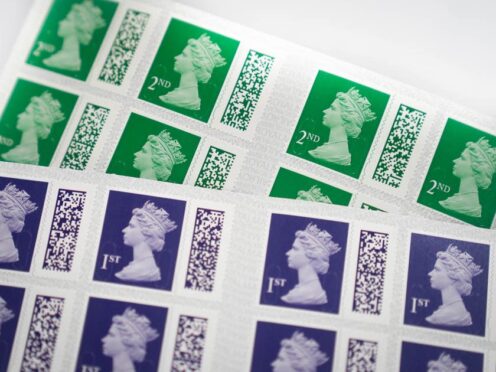Royal Mail is reportedly investigating claims that people have been wrongly fined after being sent letters with new barcoded stamps.
Members of the public have complained they had to pay £5 penalties to collect post because the stamps were deemed to be counterfeit, the Daily Telegraph reported.
The issue has emerged since the postal service switched entirely to a new barcoded system last July.
Postmasters have said the allegedly fake stamps were bought from Royal Mail directly, prompting fears that they are wrongly being identified as counterfeit.
In December, many people complained Christmas cards went undelivered.
On Tuesday night, Post Office minister Kevin Hollinrake said he had held a meeting with Royal Mail chief executive Martin Seidenberg.
Mr Hollinrake told the Telegraph: “We spoke to Royal Mail and they are investigating and they are working alongside the Post Office and other retailers to try and ascertain the source of the problem.”
Last week, Royal Mail insisted its processes are “secure” and that it uses “specialist equipment” to assess whether a stamp is genuine.
Most stamps are verified using the service’s scanning devices at sorting offices.
Royal Mail said: “Royal Mail takes the illegal production of counterfeit stamps seriously. Since the introduction of barcoded stamps we have been able to significantly reduce stamp fraud through added security features.
“Every barcode is unique which allows us to identify whether a stamp is genuine or not, and whether they have been previously used.
“We want our customers to buy stamps with confidence. We strongly recommend that customers only purchase stamps from Post Offices and other reputable High Street retailers, and not to buy stamps online – unless from the official Royal Mail shop.
“Our website provides customers with guidance on how to spot counterfeit or used stamps and we urge customers to report any suspicious stamps to Royal Mail via our website at
royalmail.com/report-stamp-fraud
so that we can investigate.
“We are working hard to remove counterfeit stamps from circulation. We regularly monitor to detect suspicious activity, such as sales of heavily discounted stamps and work closely with retailers and law enforcement agencies to identify those who produce counterfeit stamps.
“We have a robust, multistage process in place when assessing whether stamps are genuine. This includes a thorough examination using specialist equipment, then a follow-up inspection by a skilled member of the team before any stamp is marked as counterfeit or pre-used.”
A Post Office spokesman said: “Stamps are available to buy from a number of different sources. Post Office Ltd receives its stamps direct from Royal Mail’s secure printers. Customers who buy stamps at Post Offices are given an itemised receipt, and this is required to investigate any allegations of fake stamps.
“Any allegation that fake stamps have been purchased at a Post Office is extremely serious. The implication of such an allegation is that one of our postmasters, or a member of their staff, has obtained fake stamps and have chosen to sell them to customers rather than selling legitimate stamps that have come from Royal Mail’s secure printers.
“This is why we insist that any customer who thinks they may have purchased a fake stamp from a Post Office must produce an itemised receipt so that this can be looked into further.
“We welcome the recent meeting between postal affairs minister Kevin Hollinrake and Royal Mail to discuss the issue of ‘counterfeit stamps’ and that Royal Mail have reaffirmed their close work with retailers and law enforcement agencies, and that they actively seek the prosecution of those who produce counterfeit stamps.”
